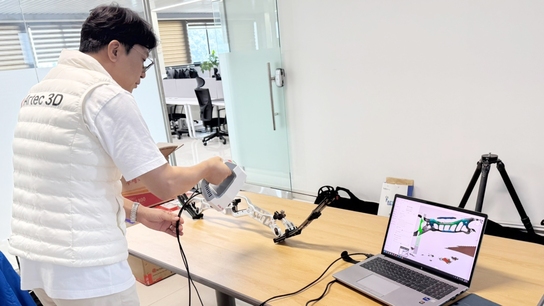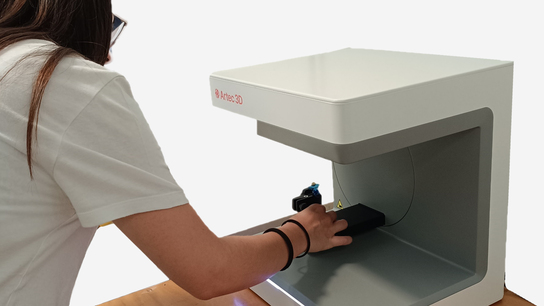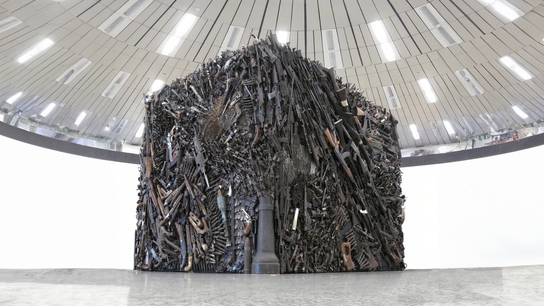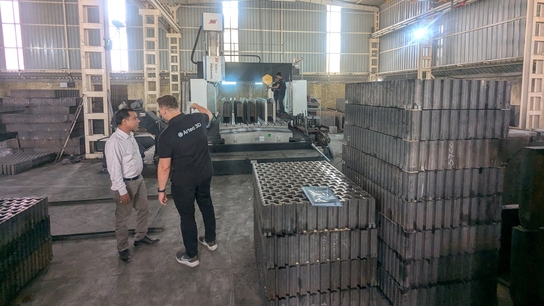Thomas More automates prosthetic customization with novel AI and Artec 3D scanning
Challenge: Developing a faster, streamlined new way of tailoring prosthetics and orthotics to patients with 3D scanning for medical professionals.
Solution: Artec Eva, Artec Leo, Artec Studio, Rhinoceros 3D
Result: A revised medical device customization workflow, revolving around a novel algorithm that’s able to make the tweaks normally applied during plaster casting, on a clinician’s behalf.
Why Artec 3D? With the lightweight, accessible Artec Eva, and later the flexible, wireless Artec Leo, Thomas More Mobilab & Care researchers trained an AI to be capable of rapidly designing prosthetic sockets for patients.

A patient having their leg 3D scanned by a Thomas More researcher with Artec Leo
Whether born with deformities, or the victims of disease or life-changing accidents, those with missing limbs encounter daily obstacles that most people don’t have to deal with. These not only arise when performing everyday tasks like lifting and carrying, but they can take on a mental form, among patients who suffer from social anxieties or phantom limb pain.
At present, when such amputees opt for prosthetics, they tend to be fitted for a socket via traditional plaster casting. This process, which sees partial limbs measured manually, can be highly time-consuming and quickly become uncomfortable for patients. In many cases, the resulting casts aren’t kept in storage either, meaning that measurements which could still be valuable later on are lost, and clinics often throw away expensive plaster materials.
Fortunately, researchers like those at the Thomas More Mobilab & Care lab continue to seek out new ways of making prosthetic customization less invasive and easier for clinicians. With the help of Artec 3D scanning, it appears they’re now nearing a breakthrough.
Digitizing prosthetic design
Working from their base in the Belgian city of Geel, the Mobilab & Care lab team is dedicated to improving quality of life for those with care or support needs. Over the last 16 years, their efforts have seen them investigate the way orthopedic physicians and patients interact and seek out new approaches to creating better-tailored devices.
One of the many ways the researchers have attempted to do so is with the help of advanced technologies like 3D scanning and 3D printing. According to the team, digitizing the process of tailoring prosthetics, sockets, and limbs to patients allows them to be designed with greater creative freedom and manufactured much more quickly.
Though nominally a research group of the Thomas More University of Applied Sciences, the Mobilab & Care crew has been able to strike many partnerships with orthopedic firms, hospitals, and academic institutions to put their ideas to the test. So far, these projects have taken place in both clinical and scholarly settings and seen the researchers work with clinicians and patients to develop custom prostheses and orthoses for hands, wrists, and other affected limbs.

Thomas More Mobilab & Care researchers using their Artec Leo in another project
Early on in these initiatives, Mobilab & Care Researcher and Business Developer Tom Saey says they identified a gap in the market: between the 3D scanners most often applied by clinicians and what they actually needed.
“We noticed that within the orthotic industry, they’d been using 3D scanners for some time, only not to 3D print orthoses, but mill positive models instead,” explained Saey. “But back then, most of the scanners used were sold by the suppliers of these milling systems and the software that came with them. We also looked at these scanners, but soon ran into limitations.”
Based on their findings, Saey and his colleagues began seeking a more capable alternative. At first, his team had success limb-scanning with Artec Eva, but Saey says it was clear from the day Artec Ambassador 4C Creative CAD CAM Consultants introduced him to the wireless, AI-powered Artec Leo that its built-in display would help take these efforts to another level.
“When we used wired scanners with students, we noticed that looking at a computer screen while you scan makes it difficult,” said Saey. “For a lot of people, that’s a big disadvantage. Also, if you’re scanning patients, and you need to move around them, it’s always easier to do so when you have no wires. Those are the two main reasons we adopted Leo.”

The researchers say Artec Leo’s built-in display is one of the main reasons they bought it
4C Creative CAD CAM Consultants Director Edwin Rappard also believes the contact-free nature of 3D scanning makes it ideal for switching from messy casting to digital measurement.
“The huge advantage in using a scanner to take accurate measurements is that there is no need to touch the patient at all. It’s therefore much more convenient,” said Rappard. “With Artec Eva and Leo, valuable measurements can be kept and stored electronically, not lost when plaster is discarded as waste. These are big advantages compared to taking measurements with plaster.”
Automating scanning with AI
After adopting Artec Leo, the Mobilab & Care team swiftly put it to good use, as part of a research project with Belgian firm Orthobroker, set up to develop a predictive model for designing lower limb prosthetics. According to Saey, these devices currently need to be “designed from scratch” each time, in a process that requires “a lot of CAD software operations” and manual corrections.
However, as the vast majority of these changes are similar for many patients, the researchers’ AI algorithm is said to be capable of predicting and making changes automatically.
So how did the software learn how to do this? That’s where Artec 3D scanning came into play.
With both their Eva and Leo devices, the team were able to accurately capture the bodies of a large group of amputees before exporting the resulting 3D meshes to Rhino 3D, a CAD software best known for its freeform modeling tools. Once imported, the models’ key features were extracted and used to train their predictive prosthesis customization model.
Though still under R&D by Orthobroker, it’s said that once finished, the algorithm will be integrated into a platform that can be used to accelerate prosthetic socket design.

In the future, the team believe speed, accuracy, and accessibility will drive 3D scanning adoption
“What clinicians normally do is make corrections to a mold before they use it to make the final prosthetic. But 95% of the corrections they do are similar in many patients,” said Saey. “We set out to predict these just based on the scan of the patient’s stump and some other parameters. This way, we can avoid the traditional need to spend hours in front of a computer, and they can still make small, patient-specific changes themselves.”
3D scanning’s medical future
While Orthobroker continues fine-tuning this AI-led predictive model, the Mobilab & Care team has resumed its hunt to find further ways of improving life for amputees everywhere. When it comes to 3D scanning, Saey claims the technology has an important role to play in this, but he says devices need to be quick, accurate, and easy to pick up, to find widespread adoption.
In his experience, Saey has found Artec 3D scanning ticks all the right boxes in each of these areas. When processing scans on Artec Studio, he says he’s particularly fond of the way you can go in-depth “into the frames and do whatever you want” or automate this step with the program’s Autopilot – an ideal feature for doctors needing to scan high numbers of patients.
Moving forward, Saey believes that Artec Leo also has strong credentials as a prosthetic customization tool, as it’s able to measure patients’ bodies with a level of speed and accuracy that is unmatched by the devices clinicians currently use.
“What we see in the sector is that a lot of companies look at cheaper alternatives, but they need to know the downsides of these, because you can’t expect to get the same high-quality scans from them,” concluded Saey. “If you need accuracy, it’s important to use a decent scanner, because if you intend to 3D print devices and start with a bad scan, your outcome will be bad as well. So I think weighing this up is an important first step.”
“In the medical field, there are certainly more applications we can use it for. I think the customization of almost all orthotic devices could benefit from 3D scanning.”
Scanners behind the story
Try out the world's leading handheld 3D scanners.






